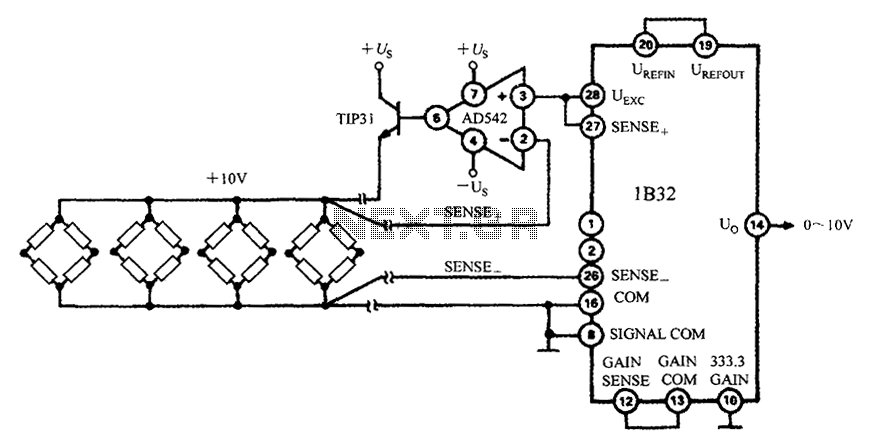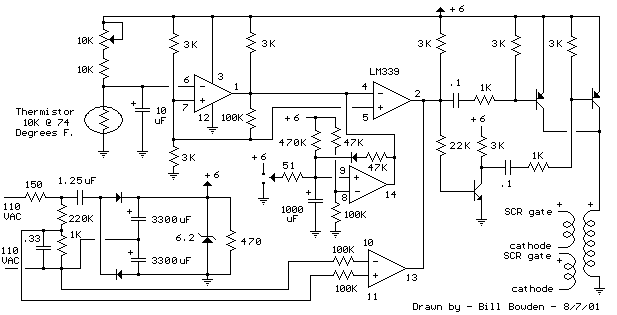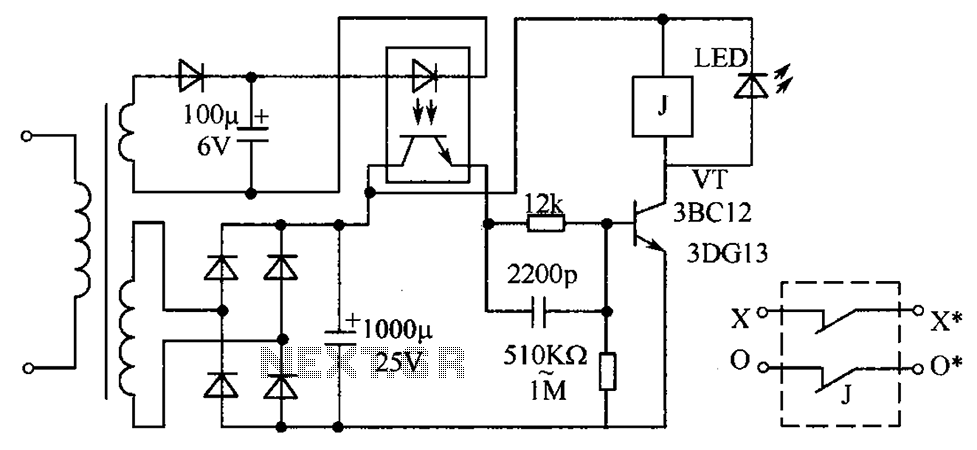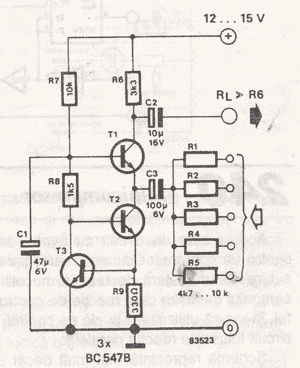
MM5314N Driven Digital Clock Circuit
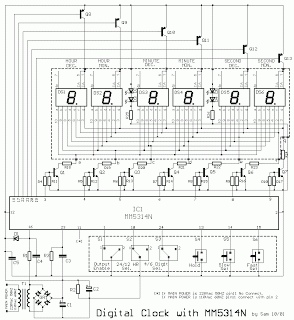
The MM5314 is a monolithic MOS integrated circuit that incorporates P-channel low threshold enhancement mode and ion implanted depletion mode devices. It features an internal multiplex oscillator, fast and slow set controls, a single power supply, 7-segment outputs, leading zero blanking, and operates at 50 Hz or 60 Hz with a 12 or 24-hour display format. The 7-segment LED serves as an electronic display device for decimal numerals, providing an alternative to more complex dot-matrix displays, and is often utilized in digital clocks, which display time numerically rather than with moving hands. The design of this circuit primarily revolves around the MM5314N MOS IC, with additional circuits functioning in conjunction with it and utilizing six common anode 7-segment displays. The common anode configuration minimizes the wiring between the LED modules by connecting all positive ends together. In practical design, the longest pin of the LED represents the positive or anode part. The 7-segment displays are driven by thirteen transistors, specifically BC550 and BC560. The circuit's timing is governed by a frequency of 50 Hz, representing a straightforward solution. To ensure stable output frequency, a crystal oscillator may be employed, utilizing a quartz crystal to generate fixed frequency oscillations, with an emphasis on accuracy and stability. The six 7-segment common anode displays provide the time output, with LEDs DS1 and DS2 indicating hours, DS3 and DS4 for minutes, and DS5 and DS6 for seconds. The collectors of transistors Q8 to Q13 supply power to the common anode of each display. Each display consists of individual LEDs labeled a, b, c, d, e, f, and g, which are connected in parallel and driven by transistors Q1 to Q7. This configuration establishes a multiplexing system operating at a frequency of 1 kHz, controlled by the RC circuit comprising R3 and C3. The power supply features a standard circuit with a bridge rectifier across the secondary coil and a parallel capacitor for smoothing. Resistor R2 and capacitors C2 to C5 manage voltage separation and limitation to protect the integrated circuit from surges and peaks. The diode D1 limits the rectified voltage at pin 16, while resistors R18 to R24 restrict excess current flowing to the LEDs. Switch S1, when positioned to adjust the clock, remains open unless switched to another position, which fixes the display value and saves the settings, allowing the clock to resume operation. This arrangement facilitates placing the clock at a suitable distance to mitigate LED display light interference. Switch S2 adjusts the clock for 12-hour or 24-hour operation by altering contact positions. Seconds adjustments are enabled when switch S3 is in position 1, with settings saved upon switching to position 2. During clock interruptions, switches S3, S4, and S5 can be utilized for adjustments; these are push-to-make switches that return to their normally open state upon release, similar to standard doorbell switches. The main voltage frequency of 50 Hz or 60 Hz is fed into pin 11, which connects to pin 2 when the main voltage is 110 VAC at 60 Hz. If the main voltage is 220 VAC at 50 Hz, pin 11 remains unconnected. Pin 16 processes the incoming 50 Hz or 60 Hz signal sampled from the main voltage, triggering the counter circuits to facilitate time adjustments. A 110 V input connects pin 11 to Vss at pin 2, while a 220 V input disables pin 11's function.
The MM5314 integrated circuit is designed for use in digital clocks, providing a compact and efficient solution for timekeeping applications. The integration of P-channel MOS technology allows for low power consumption and high reliability, essential for consumer electronics. The internal multiplex oscillator enables the driving of multiple displays without the need for complex additional circuitry, simplifying the overall design.
The common anode configuration of the 7-segment displays not only reduces wiring complexity but also enhances the circuit's robustness by allowing all positive terminals to be connected together, which is particularly beneficial in minimizing the risk of short circuits. The use of transistors to drive the individual segments of the displays ensures that each segment can be controlled independently, allowing for precise representation of time.
The timing accuracy of the circuit is crucial for maintaining correct time, which is why the inclusion of a crystal oscillator is recommended. This oscillator provides a stable frequency reference that significantly enhances the precision of the clock. The design also incorporates various protective measures, such as the use of diodes and resistors, to safeguard the integrated circuit from voltage spikes and excessive current, ensuring longevity and reliability in operation.
The user interface, facilitated by switches S1, S2, and S3, allows for easy adjustments of the clock settings, accommodating user preferences for 12-hour or 24-hour formats and enabling quick corrections to the time. The push-to-make functionality of the switches ensures that adjustments can be made efficiently without the need for continuous engagement, enhancing user experience.
In summary, the MM5314-based digital clock circuit represents a well-engineered solution for timekeeping, combining advanced MOS technology with practical design considerations to deliver accurate and reliable performance in a user-friendly package.MM5314 a monolithic MOS integrated circuit that utilizes P-channel low threshold, enhancement mode and ion planted, depletion mode devices which has features such as internal multiplex oscillator, fast and slow set controls, single power supply, 7-segment outputs, leading zero blanking, operating at 50 Hz or 60 Hz, and 12 or 24 hour display fo rmat 7 Segment LED is a form of electronic display device for displaying decimal numerals that is an alternative to the more complex dot-matrix displays also known as seven-segment indicator A digital clock is a type of clock in which the time is displayed in a numerical form being associated with electronic devices. It uses a digital display rather than moving hands. The basis of the circuit design evolves in a single MOS IC MM5314N. Other necessary circuits are operated through the MM5314 IC which works together with six common anode 7-segment displays.
The multisegment LED common anode configuration reduces the number of wires between the LED modules where all positive ends are connected together. In practical design, the longest pin of the LED is the positive or the anode part. The 7-segment displays are driven by thirteen transistors consisting of BC550 and BC560. The timing of the circuit is determined by the frequency of the network with a value of 50 Hz, which imposes the simplest solution.
To maintain a stable output frequency, a crystal oscillator may be used. It uses a quartz crystal to produce fixed frequency oscillations where accuracy and stability are the primary considerations. It uses the mechanical resonance of a vibrating crystal to produce a very precise frequency from the creation of an electrical signal.
The six displays of 7-segment common anode provide the output for the time. LEDs DS1 and DS2 represent the Hour, LEDs DS3 and DS4 represent the Minutes, and LEDs DS5 and DS6 represent the Seconds. The collector of transistors Q8 to Q13 powers the common anode of each display. Each display consists of individual LEDs a, b, c, d, e, f, & g, are linked in parallel combination, which are then driven by the transistors Q1 to Q7.
This type of connection creates a multiplexing system with a frequency of 1 KHz that is controlled by the RC circuit R3 and C3. The power supply contains the typical circuit having a bridge rectifier across the secondary coil with a parallel capacitor across the bridge.
The resistor R2 and capacitors C2 to C5 handles the separation and limiting of voltage to protect the integrated circuit from surge and peak voltages. The rectified vibrations in pin 16 are limited by the diode D1 while resistors R18 to R24 are limiting the excess current from the LED.
The use of switch S1, if put in position 1, is to adjust the clock to the required time and display. It will remain open unless it is switched to the other position which causes the display to be in a fixed value and save the settings, resuming the operation of the clock. In this scenario, the clock may be placed with a tolerable distance to avoid the effect of light from the LED display.
Switch S2 on the other hand is responsible for adjusting the clock to operate on a 12-hour or 24-hour basis by changing the positions of the contacts. The adjustments of seconds are made possible when switch S3 is in position 1. The setting for the seconds is saved when the contact is changed to position 2. During an interruption in the operation of the clock, switches S3, S4, and S5 can be used for alterations.
These are push-to-make switches which return to its normally open or OFF position upon releasing the button, like the standard doorbell switch. The frequency of the main voltage around 50 Hz or 60 Hz is fed into pin 11 which is connected to pin 2 if the main voltage is 110 VAC at 60 Hz.
Otherwise, pin 11 will not be connected anywhere if the main voltage is 220 VAC at 50 Hz. Pin 16 handles the incoming 50 Hz or 60 Hz at the input with the sample from the main voltage. The counter circuits are triggered by the sample function which becomes the adjustment of time. Having 110 V causes the pin 11 to connect Vss at pin 2 while having a 220 V nulls the function of pin 11. 🔗 External reference
The MM5314 integrated circuit is designed for use in digital clocks, providing a compact and efficient solution for timekeeping applications. The integration of P-channel MOS technology allows for low power consumption and high reliability, essential for consumer electronics. The internal multiplex oscillator enables the driving of multiple displays without the need for complex additional circuitry, simplifying the overall design.
The common anode configuration of the 7-segment displays not only reduces wiring complexity but also enhances the circuit's robustness by allowing all positive terminals to be connected together, which is particularly beneficial in minimizing the risk of short circuits. The use of transistors to drive the individual segments of the displays ensures that each segment can be controlled independently, allowing for precise representation of time.
The timing accuracy of the circuit is crucial for maintaining correct time, which is why the inclusion of a crystal oscillator is recommended. This oscillator provides a stable frequency reference that significantly enhances the precision of the clock. The design also incorporates various protective measures, such as the use of diodes and resistors, to safeguard the integrated circuit from voltage spikes and excessive current, ensuring longevity and reliability in operation.
The user interface, facilitated by switches S1, S2, and S3, allows for easy adjustments of the clock settings, accommodating user preferences for 12-hour or 24-hour formats and enabling quick corrections to the time. The push-to-make functionality of the switches ensures that adjustments can be made efficiently without the need for continuous engagement, enhancing user experience.
In summary, the MM5314-based digital clock circuit represents a well-engineered solution for timekeeping, combining advanced MOS technology with practical design considerations to deliver accurate and reliable performance in a user-friendly package.MM5314 a monolithic MOS integrated circuit that utilizes P-channel low threshold, enhancement mode and ion planted, depletion mode devices which has features such as internal multiplex oscillator, fast and slow set controls, single power supply, 7-segment outputs, leading zero blanking, operating at 50 Hz or 60 Hz, and 12 or 24 hour display fo rmat 7 Segment LED is a form of electronic display device for displaying decimal numerals that is an alternative to the more complex dot-matrix displays also known as seven-segment indicator A digital clock is a type of clock in which the time is displayed in a numerical form being associated with electronic devices. It uses a digital display rather than moving hands. The basis of the circuit design evolves in a single MOS IC MM5314N. Other necessary circuits are operated through the MM5314 IC which works together with six common anode 7-segment displays.
The multisegment LED common anode configuration reduces the number of wires between the LED modules where all positive ends are connected together. In practical design, the longest pin of the LED is the positive or the anode part. The 7-segment displays are driven by thirteen transistors consisting of BC550 and BC560. The timing of the circuit is determined by the frequency of the network with a value of 50 Hz, which imposes the simplest solution.
To maintain a stable output frequency, a crystal oscillator may be used. It uses a quartz crystal to produce fixed frequency oscillations where accuracy and stability are the primary considerations. It uses the mechanical resonance of a vibrating crystal to produce a very precise frequency from the creation of an electrical signal.
The six displays of 7-segment common anode provide the output for the time. LEDs DS1 and DS2 represent the Hour, LEDs DS3 and DS4 represent the Minutes, and LEDs DS5 and DS6 represent the Seconds. The collector of transistors Q8 to Q13 powers the common anode of each display. Each display consists of individual LEDs a, b, c, d, e, f, & g, are linked in parallel combination, which are then driven by the transistors Q1 to Q7.
This type of connection creates a multiplexing system with a frequency of 1 KHz that is controlled by the RC circuit R3 and C3. The power supply contains the typical circuit having a bridge rectifier across the secondary coil with a parallel capacitor across the bridge.
The resistor R2 and capacitors C2 to C5 handles the separation and limiting of voltage to protect the integrated circuit from surge and peak voltages. The rectified vibrations in pin 16 are limited by the diode D1 while resistors R18 to R24 are limiting the excess current from the LED.
The use of switch S1, if put in position 1, is to adjust the clock to the required time and display. It will remain open unless it is switched to the other position which causes the display to be in a fixed value and save the settings, resuming the operation of the clock. In this scenario, the clock may be placed with a tolerable distance to avoid the effect of light from the LED display.
Switch S2 on the other hand is responsible for adjusting the clock to operate on a 12-hour or 24-hour basis by changing the positions of the contacts. The adjustments of seconds are made possible when switch S3 is in position 1. The setting for the seconds is saved when the contact is changed to position 2. During an interruption in the operation of the clock, switches S3, S4, and S5 can be used for alterations.
These are push-to-make switches which return to its normally open or OFF position upon releasing the button, like the standard doorbell switch. The frequency of the main voltage around 50 Hz or 60 Hz is fed into pin 11 which is connected to pin 2 if the main voltage is 110 VAC at 60 Hz.
Otherwise, pin 11 will not be connected anywhere if the main voltage is 220 VAC at 50 Hz. Pin 16 handles the incoming 50 Hz or 60 Hz at the input with the sample from the main voltage. The counter circuits are triggered by the sample function which becomes the adjustment of time. Having 110 V causes the pin 11 to connect Vss at pin 2 while having a 220 V nulls the function of pin 11. 🔗 External reference
